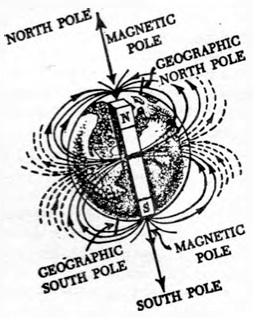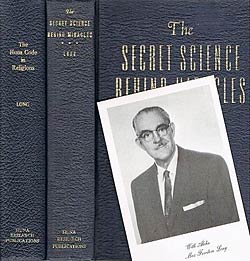 |
|
January – March, 1976
| Huna Research Associates Dr. E. Otha Wingo, Editor 126 Camellia Drive Cape Girardeau, MO 63701 |
The Max Freedom Long Library Dolly Ware, Curator 1501 Thomas Place Fort Worth, TX 76107 |
BIOMAGNETICS, PART I
You have read the background for the study of Bio-Magnetics in No. 16, which covered “classical” or orthodox studies in the physics of magnetism. This bulletin explores the researches and discoveries of ALBERT ROY DAVIS and WALTER RAWLS, JR. concerning the effects of separate polarities on living systems.
WHAT DO A CARTON OF FISHING WORMS AND A PAIR OF BROKEN EYEGLASSES HAVE IN COMMON?
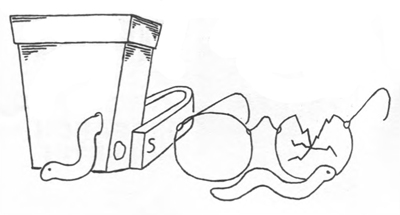 In H.V. Newsletter #13, I reported on John Ott’s discovery of the sunlight’s effect on bodily functions through the eyes. His work with time-lapse photography had led to research on the interaction of light and darkness upon plant growth. One day he broke his eyeglasses, and while waiting for replacements, decided to catch up on his gardening. After a few days of exposure to the sun, a remarkable thing happened. His arthritic symptoms had diminished. Here the circumstances were just right for a man accustomed to noticing the effects of light to make an important discovery about the connection between sunlight and the eyes.
In H.V. Newsletter #13, I reported on John Ott’s discovery of the sunlight’s effect on bodily functions through the eyes. His work with time-lapse photography had led to research on the interaction of light and darkness upon plant growth. One day he broke his eyeglasses, and while waiting for replacements, decided to catch up on his gardening. After a few days of exposure to the sun, a remarkable thing happened. His arthritic symptoms had diminished. Here the circumstances were just right for a man accustomed to noticing the effects of light to make an important discovery about the connection between sunlight and the eyes.
To the layman this discovery might seem “accidental,” but all scientists who deal with research in unexplored fields seem to receive some form of “guidance,” intuitive insight or serendipitous connection between seemingly unrelated facts.
Bio-Magnetics, Part 2
In 1936 a researcher with an interest in magnetism decided to spend the afternoon relaxing on a fishing trip. He obtained three cardboard containers of earthworms to be used as bait and set them aside on the workbench. The afternoon soon became filled with work and the fishing trip was forgotten. While shuffling things around, one box of worms was “accidentally” pushed up against the south pole of a large horseshoe magnet and left overnight. Upon returning the next morning, he found that the worms were no longer in their carton, but had eaten through the sides and were crawling around on the workbench. Those in the boxes away from the magnet were still inside.
Wondering if the magnet had caused this, he decided to do further research. He scooped up the loose worms and put them back into new, heavier cardboard boxes. This time he placed a box next to each pole of the magnet and left the third as a control, free from any influence of the magnet. After repeating this experiment many times, he drew up the following conclusion: “In the S pole container the earthworms were still present and alive, though they had been busy chewing on the inside of their container. They were approximately one-third larger, longer in length and larger in diameter and were extremely active. Evidence of young worms in the soil showed a number of babies had been born.
“The N pole container produced different results as many of the earthworms had died and those still alive were thin and showed little activity.
“The control container showed no difference one way or the other.” (Magnetism, pp. 26-27)
This opened a new door into the field of Bio-Magnetics and for Albert Roy Davis a life-long quest to change the out-dated belief that the two poles of a magnet are homogeneous.
Canadian-born, Albert Roy Davis moved to the U.S. in 1922 and entered the University of Florida in 1936. Just two years later he established the Albert Roy Davis Research Laboratory in Green Cove Springs, where research is still going strong.
At a later date he was joined by a noted lawyer, business executive and researcher with an interest in Bio-Magnetics, Walter C. Rawls, Jr. Together they have been testing and retesting the effects of the two different poles of a magnet and have published their findings in three books:
- The Anatomy of BIOMAGNETISM; 55 pp. (privately printed, paperback). Preliminary reports of the effects of separate poles on living systems. (This book is largely replaced by the two others, but is available for $6.95 from the author.) 1974.
- Magnetism and its Effects on the Living System; xxii + 132 pp. (Exposition Press, 900 South Oyster Bay Road, Hicksville, New York 11801) $8.00. Available from the publisher or from the authors. Well illustrated, including one color plate. Clearly shows the difference in older, mistaken ideas about magnetism and up-dated developments, with details of many experiments. 1974.
- The Magnetic Effect; 128pp. $6.00. Available from the publisher (Exposition Press) or from the authors. Explores many physical ailments with specific effects of the two different magnetic poles. 1975.
These books are the source of the information presented in this article, which is basically a review of the work of Davis and Rawls.
 THE TRADITIONAL VIEW OF A MAGNETIC FIELD
THE TRADITIONAL VIEW OF A MAGNETIC FIELD
The conventional method of showing the pattern of magnetic “flow” is the typical classroom demonstration using a magnet and iron filings. (See illustration.) It is easily reproducible by anyone and is considered to be a graphic indication of what a magnetic field is. All you need is a sheet of paper, some metal filings (iron) and a magnet. Spread the filings around the sheet of paper. Holding the paper with one hand, bring the magnet underneath, so that the filings come in contact with the magnet’s force field. These filings will re-arrange themselves into lines running from pole to pole, as in the drawing.
The result will be exactly the same, either with different filings, different magnets, or either pole of the magnet pointing in any direction. It is well understood that each filing actually becomes a separate and distinct magnet and they line up according to opposite polarities. Yet the scientific community still considers this demonstration to indicate actual “lines of force” or directions of force.
As a result of tests with the earthworms and the different effects of the two poles, Davis and Rawls began to wonder if this fundamental test could also be obsolete — or at least show something different from what was supposed. A Cathode Ray Oscilloscope was used in trying to photograph these lines of magnetism. At the heart of the Oscilloscope is the cathode ray vacuum tube, which generates a focused beam of electrons that can be deflected by magnetic fields onto a special translucent screen. To everyone’s amazement, the lines weren’t lines at all, but more like miniature cables. Dr. Davis describes them as follows:
“The direction of the movement’s spins of the electrons (magnetic energy) was reverse in nature, one to the other. In fact, the energy coming from the south pole of a magnet moved, travel, and took on a spinning vortex of energy that cycled, moved to the right or clockwise; while that energy coming from the north pole of a magnet spun, moved, cycled to the left or counter-clockwise.
“This discovery was not confirmed until the development of the present space age and the actual magnetic measurements that were made by complex technical magnetometers from space. The energy of a magnet, like that of the energy of the Earth’s two magnetic poles, the North and south Poles, did not simply leave one pole and travel around the magnet to re-enter the other end of the magnet, but on leaving the south pole it travels only half way around the magnet where it alters its electronic spin, taking on a reverse spin and resultant form of energy to then leave that center of the magnet or Earth and continue on to re-enter the north pole of the magnet, or Earth.” (Anatomy, p. 11)
These new concepts are illustrated by the following drawings taken from Magnetism, p. 22:
“The earth, like a bar magnet or any magnet, has a magnetic equator and it is at that point where the spins of electrons change their phase relationship and present us two fields of energies and two different potentials of magnetic energy.” (p. 56)
This figure 8 (known as lemniscate or Lissajous) is another new concept in the field of magnetism. At the exact center of the magnet, where the electron spin alters its direction, the effect is neutral and is known as the Bloch Wall.
The precise identification of the poles is most important. Davis and Rawls “refer to the north pole of the magnet, NOT the north-seeking pole, as many books describe. AS the north-seeking pole of any magnet is in fact THE SOUTH POLE of that magnet.” What this amounts to is exchanging the markings north and south on commercial magnets in order to designate the precise polarity of the magnet itself. If the pole of a magnet marked North is the north-attracting pole, then in actuality it must be the south pole of the magnet, as opposites attract and likes repel.
EXPERIMENTS WITH SEEDS
After verifying the results with earthworms with many repeated experiments, Davis and Rawls turned their attention to other living systems. They tested the effect of magnetic fields on the germination of seeds. As in all their experiments, three separate groups were used: one for each polarity of the magnet and the third as a control. After hundreds of tests, the results were similar: “larger plants as a result of the seed’s exposure to the S pole and smaller plants as a result of exposure to the N pole of a magnet” (Magnetism, p. 29).
 EXPERIMENTS WITH RODENTS
EXPERIMENTS WITH RODENTS
Not content with these findings, they began to analyze the reactions of rodents under the influence of the two separate polarities. Again the results showed the same as in their previous experiments. Those subject to the S pole became more active, produced more and healthier offspring; while those subdued by the N pole became sluggish, losing their desire for sex and interest in raising young. But, one thing they found that their former testing had not shown was the “psychological” response: “The apparently high sensitive behavior to lights, sounds, motion, movement in the laboratory, by the N pole mice and rats as opposed to the boldness, strong, nonfearful behavior of the S pole mice and rats showed a remarkable difference in the psychological behavior pattern of the rodents. These differences coincided with our findings relative to the particular pole energies.” (Magnetism, p. 38)
Length of treatment became of the utmost importance, as each pole magnifies its intensity as a result of over exposure. If the rodents were left in contact with the S pole for more than a couple of days, they became hostile, while a two-day exposure of the N pole produced extreme weakness. Therefore, it became necessary to spread the length of treatments out, with intervals in between.
Thousands upon thousands of experiments have been made in the past forty years and the precise results of the two separate polarities have been verified.
APPLICATION IN HUMAN AILMENTS
The following are four examples of the application of magnetic polarities for human ailments:
- ARTHRITIS – The inflammation of the joints by small hair-like fibers of calcium is known as arthritis. Here the idea is to slow down the growth of these calcium deposits. “We used the North pole of the biomagnet for 30 to 40 minutes twice a day. Results were shown by x-rays taken before and after a series of exposures to the north pole magnetic energy. Many cases responded well.” (Magnetic Effect, p. 39)
- KIDNEY RESEARCH – Pain and swelling of the lower back region, with very dark urine containing pus usually indicate an inflammation of the kidneys. “The approach is to place the NORTH pole of the biomagnet directly against the kidney location for 40 minutes to an hour once or twice a day, morning and evening hours best. In a very short time, pain, swelling, and pus discharge have been reduced; there is also a clearer urine color.” (Magnetic Effect, p. 65)
- DIGESTION AND STOMACH GAS – Without sufficient amounts of hydrochloric acid in the stomach, food cannot be properly digested. Fermentation of this food produces indigestion and gas. “In large and small animal research, and in limited willing human subjects, we found that tack of acids, not excess acids, in the stomach, could be the cause for stomach gas, upset stomach, and indigestion… Application of the South pole energies increases the natural acid exchange in the stomach, thus relieving these stomach conditions.” (Magnetic Effect, pp. 54, 55)
- CANCER – Of all their findings, Davis and Rawls have found the most satisfaction in the arrest of cancer cells. “We have shown in our research that the growth and multiplication of cancer cells can be arrested and eliminated by negative magnetic energy.” (Magnetic Effect, p. 53)
By “negative” they mean, of course, the North pole of the magnet. Here the cancerous cells can be detained long enough for the healthy cells to re-group and fight off the virus. One point worth mentioning here is that they found it next to impossible to transplant the cancer onto healthy cells. The test area had to be infected before the diseased cells could survive.
AKA LIMBS?
At present, research is extending into the field of amputated limbs. The basic research was done some twelve years ago; however, in spite of expressed interest, no medical researchers took up the investigation. Most experiments necessarily involved animals. Some success is reported in the book, The Magnetic Effect, Chapter V — enough to suggest that it is worth continuing the research. The north pole application aided in getting rid of the “feeling” in the missing limb, in some human subjects. The activating south pole was the one used with animals for bringing about some “expansion of tissue.” Is this a partial verification of the Huna theory of aka blueprints of the physical body?
WIDE SCOPE OF RESEARCH AREAS
Davis and Rawls have experimented with just about every major complaint. Although they list some fine results, they do not claim this as a cure-all. The following list will give you an idea of the items covered in the report (The Magnetic Effect): appendix, arthritis, bladder, hemorrhage, blood clots, blood pressure, broken bones, bronchitis, burns, hearing problems, eyes (glaucoma, cataracts), headaches, infection, colds, neuritis, sinusitis, spinal curve, sprains, teeth and gums, ulcers.
If you wish to use the information and examples in this report as a guide and experiment on your own, you should keep the length of treatment at about 30 to 60 minutes, two or three times a day, and remember: “THE NORTH POLE REDUCES, WHILE THE SOUTH POLE INCREASES”. (Magnetic Effect, p. 70)
By now you should have a fairly plain idea about the effects of the two distinct polarities of magnetism. Now you need a magnet to do your own experimenting. Although many researchers use the electro-magnet, Davis and Rawls have determined that the composition magnet is far superior. “Any kind of electro-magnet consists of many turns of insulated wire; each turn of this wire presents so many lines of magnetism, so a coil wound to have a certain number of turns then has a different frequency from that of a fixed or metal or composition magnet.” (Anatomy, p. 40) While searching for the proper composition magnet, they have found the horseshoe magnet of little value. The poles are too close together to give an individual effect. As the principle is to apply “one” pole at a time, magnets with their poles physically well apart work best. The plain bar magnet is more practical for this purpose.
Commercial magnets can be used, but they present a number of problems compared to those developed by Davis and Rawls in their laboratory. To begin with, the labeling of the poles is misleading, and you may tend to forget to reverse these. Instead of “North attracting” (used in commercial magnets), Davis and Rawls call it the South Pole, and their own magnets are so labeled.
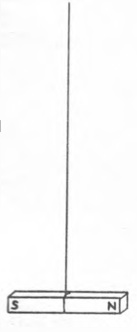 HOW TO FIND THE TRUE POLES OF A MAGNET
HOW TO FIND THE TRUE POLES OF A MAGNET
One easy way of locating the true poles of a commercial magnet is to tie a long string around the exact center (Bloch Wall) of a bar magnet and suspend it so that it hangs free without interference. The magnet will swing or turn for a while. When it stops, it will be aligned with the polarity of the earth. The South pole of the magnet will point to wards the earth’s magnetic North and the north pole of the magnet will point to the earth’s South.
STRENGTH OF A MAGNET
The unit of measurement for the intensity strength of magnets is the gauss. Since most manufacturers use “lifting power” to designate supposed “strength” of magnets, this too can present a problem. Often suppliers cannot give you the proper gauss rating of magnets purchased from them. A Gauss-meter (or magnetometer) would be required. Davis and Rawls used magnets (which they developed) with fairly consistent strengths measured in gauss units. Mostly 3000 gauss magnets were used. They do give a rule-of-thumb to use in attempting to experiment with commercial magnets: a lifting power of 2 lbs. is about 500 to 600 gauss; 5 lbs. is about 900 to 1200 gauss; 25 lbs. is close to 2000; a 50 lb. lift would be 3500 to 4500. From this you can see how difficult it is to determine exactly what is being used. However, once the polarity is established and the approximate strength in gauss units, you are ready to begin.
SPECIAL BIO-MAGNETS DEVELOPED BY DAVIS
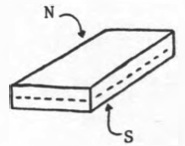 In order to obviate the problems presented by commercial-grade magnets, Dr. Davis has developed a special composition magnet, called a Bio-Magnet for using in experiments. The poles are properly marked according to methods described in his books and strength marked in gauss units (usually 3000 gauss). Since the area of treatment is usually larger than the small ends of bar magnets, Dr. Davis’s Bio-Magnets are polarized on the FLAT SIDES, rather than on the ends. This is much more convenient to use, and in addition, the experiments can be controlled. Application is possible on a larger variety of problems.
In order to obviate the problems presented by commercial-grade magnets, Dr. Davis has developed a special composition magnet, called a Bio-Magnet for using in experiments. The poles are properly marked according to methods described in his books and strength marked in gauss units (usually 3000 gauss). Since the area of treatment is usually larger than the small ends of bar magnets, Dr. Davis’s Bio-Magnets are polarized on the FLAT SIDES, rather than on the ends. This is much more convenient to use, and in addition, the experiments can be controlled. Application is possible on a larger variety of problems.
In comparison, we checked a commercial magnet that was approximately the same size as Dr. Davis’s N-l Bio-Magnet (6x2x½ inches). The manufacturer could not tell us the gauss strength of these magnets. Upon checking, we found that they were not magnetized with poles on the flat surfaces. In fact, the material was magnetized IN SEVERAL NARROW STRIPS ALONG THE SURFACE, with no recognizable poles on any side. The Bio-Magnets are available only from the Albert Roy Davis Research Laboratory.
Today there are numerous scientists working with the new concepts formulated by Davis and Rawls. The authors give credit to many of their co-workers in the books. Though most of these are located outside the U.S. where the scientific attitude is more receptive, correspondence has been established among them and they are cooperating in furthering the research in the area of Bio-Magnetics.
RECENT INFORMATION FROM ALBERT ROY DAVIS
We are in constant communication with Dr. Davis and Dr. Rawls, and have on hand a large file of current information on Bio-Magnetics, which they have sent us. This includes many items developed for research in Bio-Magnetics, such as the N-l and N-2 Bio-Magnets, Magnetic Lens Glasses, Magnetic Ear Unit, Water-Treating Magnet, Magnetic Seed Stimulator, Magnetic Water Treatment Pencil, a Magnetometer — all available from the Lab. In addition, there are reports of two important new discoveries: scientific proof of the effects of “laying on of hands” in healing, and the invention of a MONOPOLE MAGNET.
MONOPOLE MAGNET
Dr. Davis informed me in a recent letter that he has made a Monopole Magnet — a magnet with one pole! (He adds in a side remark: “The scientific community says we have not, so I guess we haven’t. Ha!”) His news release states this is a phase of particle physics. “We have physically produced them in our laboratory. They are available for inspection to qualified persons.” This is a discovery of great importance. Even the unbelieving scientific community has had to admit to the monopole phenomenon. An article from Science News speaks of the “impossible” magnetic fields of the sun, and states: “The sun’s normal two-pole magnetic field takes on a single polarity for three solar rotations (about three months). The idea of a magnetic field with only one pole is so inconceivable to scientists that they will be watching with unusual interest to see if the phenomenon repeats itself a few months from now.” These scientists should also be watching the developments of Albert Roy Davis and Walter Rawls.
THE RAINBOW IN YOUR HANDS — new book by DAVIS and RAWLS on the “Science of Laying on of Hands”. Roy and Walter have been telling me of the research on the first book ever written that scientifically supports and INSTRUCTS the science of “laying on of hands” for healing. The book is now finished, and we hope to announce its publication very soon. It is a book of great interest to all HRAs. Watch for an announcement as soon as it is ready.
From our co-worker, JEROME EDEN, comes this statement soon after receipt of Bio-Magnetics, Part I: “A valid, comprehensible and functional study of so-called biomagnetism is not possible without a thorough knowledge of orgone energy… WILHELM REICH discovered the Life Energy and scientifically objectified it between 1936 and 1940. His solid priorities are fully established.” We appreciate Mr. Eden’s comments and agree that a study of Reich and orgone is of utmost importance. We had already planned a thorough study of Reich’s works, with one or more issues of the RESEARCH BULLETIN devoted to this important study. I am already up to my eyebrows in Reich’s books, and Mr. Eden is cooperating fully in helping to present the story properly. This study will begin in R.B. #18. — E.O.W.



